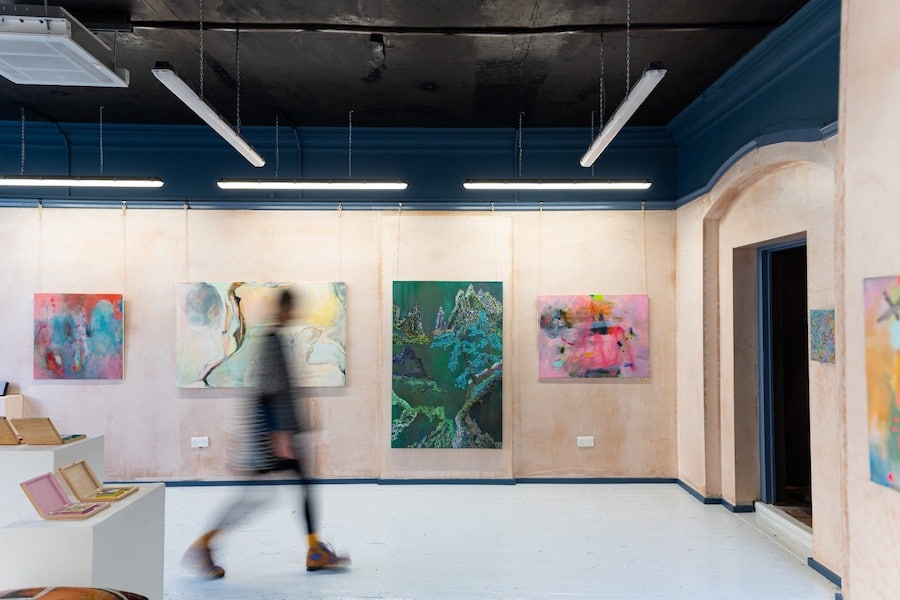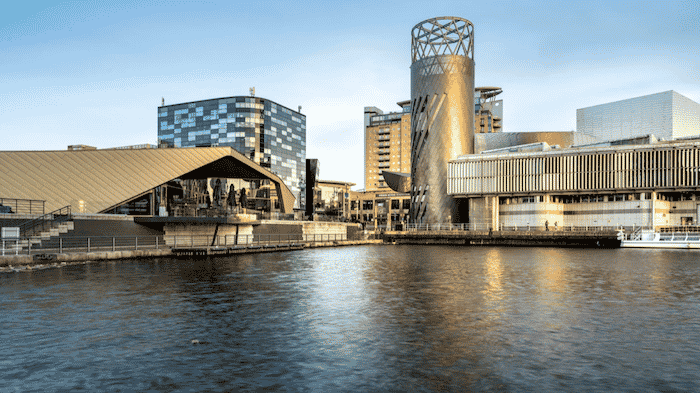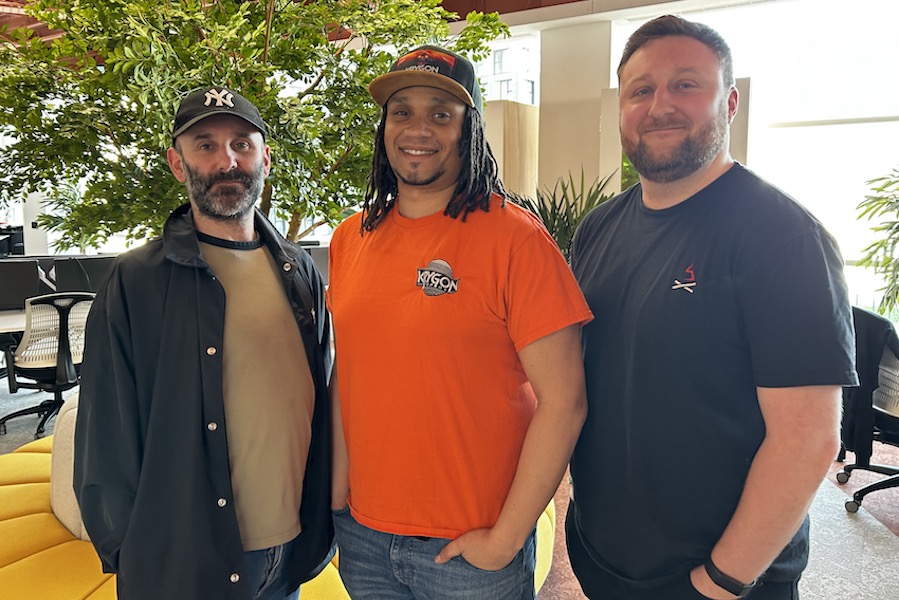The artist exploring grief, loss and recovery in Stockport exhibition
- Written by Thom Bamford
- Last updated 1 year ago
- Art & Design, Community, Culture, People, Stockport

When artist Kate Jacob lost her husband to bowel cancer in 2007 leaving her with daughter Sophie, just 16 months old at the time, her career which had been skyrocketing through regular exhibitions in the North and nationally, came to a halt.
Now, following a full-time return to painting during the pandemic, Kate is about to make an epic re-emergence with her first solo show for 20 years at Stockport’s Mura Ma gallery, opening on 26th January.
Titled ‘How to knit a nebula’, the show is her attempt to trace the voids, space, and places of loss and memory.
A nebular, a giant cloud of cosmic dust and gas, is the former site of a star, but also its birthplace.
I Love Manchester spoke to Kate about her comeback.
Kate Jacobs

Have you always been an artist?
Yes! Originally I studied Textiles at Manchester Metropolitan University, and more recently completed Fine Art courses at Turps Art School and Morley College London.
While born in London, the North has become my home and I’ve lived in Sheffield for 27 years. I’ve held exhibitions all over the UK, including Sheffield’s Graves Gallery, taught summer schools at the former Mappin Art Gallery, and founded and managed art projects including Open Up, South Yorkshire’s open studio event, which is still going strong today in its 25th year.
Tell us about your journey to this exhibition.
This new body of work explores themes of grief and loss – which I have experienced at two significant moments in my life.
In 2003, my husband Dave was diagnosed with bowel cancer and wasn’t given long to live. He fought it hard but eventually, we lost him in 2007, when my daughter Sophie was just 16 months old. He was 50 when he died, I was just 40.
I found the studio too quiet a place to be and coping as a solo parent, I think that early part of my career died with Dave.
I got back into the studio 10 years later and started a body of work exploring what we’d been through. But it wasn’t until the pandemic hit that I returned to painting full-time and this theme continued to form the work going into ‘How to knit a nebula’.
At the time I was supporting my mum who was suffering from dementia. She sadly died last summer, but before this, I was able to spend a lot of time talking to her about her fears about dying and missing out on the future and watching her grasp at the memories she was losing.
Grief is not just sadness or anger; it’s an event, a place, a moment in time all at once.
The exhibition explores the mass of thoughts, emotions and states of being, experienced over time. Grief encompasses many states including guilt, flatness, relief, euphoria, closeness, disconnection and melancholy; and we move and flow between them.
It’s not linear, it’s layered and connected.
The show at Mura Ma seems especially important and to be celebrated as it’s my opportunity to re-emerge.
Has art helped you find a pathway through grief?
Art has helped me to integrate grief into life and attempt to make sense of it.
Painting makes me examine things from every angle, it’s all-encompassing. I’m able to revisit the most fraught and emotional moments and slow them down, attempting to capture that experience and the sense of where somebody goes.
What can we expect to see in your work?
Working in acrylic and ink, the work is as accidental and playful as it is constructed and considered. Pastel colours wrestle with bright popping neon and muddy greys.
Patterns, colours and lines repeat and jump from painting to painting.
I’ve used the centre of the canvas as the focus point. Imagine zooming in on a photo and expanding and expanding and expanding, to the point where it’s lost focus and it’s as if you’ve fallen through to the other side of the image.
Tell us about your creative process.
The process isn’t linear – I’m often working on 20-30 paintings at one time, all at different stages. The canvasses rotate around my studio on different walls and they follow the speeds that I work at.
Some are unresolved and unfiltered and I work on them constantly with speed. Others I work on maybe once a day, sometimes once a week and it might be just a single brush mark or a drop of colour.
Others really need time to settle and breathe – this process can take months and on occasion, years.
This suits the way my brain works and I can see how a collection is building together. I see them as a book where each one is another page turned.
What would you say to others struggling with loss?
The physical act of moving can be incredibly helpful – whether that’s finding a creative activity or simply going for a walk. It stops you from feeling like everything has gone static.
I also think it’s important to accept how you are in a given moment – like knowing when to sleep and knowing when to run! If there was a piece of advice I wish I’d been given it would have been to accept the ebbs and flows of how grief affects us.
What does Manchester mean to you?
Having studied in Manchester in the 90s I was won over by the soul of the North. What it lacks in weather it more than makes up for in its people and heart.
The recent Manchester Art Fair and The Manchester Contemporary which I exhibited in showed the appetite and quality of art originating from the North.
There’s also some great initiatives and peer networks like Rogue Artists’ Studios and Rogue Women. Mura Ma is a particularly exciting place to be landing with my solo exhibition as its owner – Nan Collantine, an artist in her own right – champions rising creatives and particularly women with interesting stories to tell.
We met on the Turps course and bonded over painting but also our desire to create more meaningful contemporary
art exhibitions in the North.
The gallery also supports people to own and collect art in an affordable and accessible way, offering original works from emerging artists.
Mura Ma is an independent, artist-run gallery and art space in Marple, Stockport.
‘How to knit a nebula’ opens 26 January – 10 February 2024. A ‘Talk & Taste’ evening takes place Friday 9 February, 7-9pm, hosted by art historian Sara
Ricardi, in conversation with Kate Jacob along with an imaginative tasting experience from chef, Claire Woodier, inspired by Kate’s paintings (tickets £28).
Can’t make the show?
You can buy the work of Kate Jacob from Muras Ma’s online shop, priced £300 – £2,000.
You can find out more on Kate Jacob at the the Mura Ma website by clicking here
- This article was last updated 1 year ago.
- It was first published on 18 January 2024 and is subject to be updated from time to time. Please refresh or return to see the latest version.
Did we miss something? Let us know: press@ilovemanchester.com
Want to be the first to receive all the latest news stories, what’s on and events from the heart of Manchester? Sign up here.
Manchester is a successful city, but many people suffer. I Love Manchester helps raise awareness and funds to help improve the lives and prospects of people across Greater Manchester – and we can’t do it without your help. So please support us with what you can so we can continue to spread the love. Thank you in advance!
An email you’ll love. Subscribe to our newsletter to get the latest news stories delivered direct to your inbox.
Got a story worth sharing?
What’s the story? We are all ears when it comes to positive news and inspiring stories. You can send story ideas to press@ilovemanchester.com
While we can’t guarantee to publish everything, we will always consider any enquiry or idea that promotes:
- Independent new openings
- Human interest
- Not-for-profit organisations
- Community Interest Companies (CiCs) and projects
- Charities and charitable initiatives
- Affordability and offers saving people over 20%
For anything else, don’t hesitate to get in touch with us about advertorials (from £350+VAT) and advertising opportunities: advertise@ilovemanchester.com

Here’s how you can make your moves matter for dementia awareness

£14.5m cultural and creative hub to ‘mark a new chapter’ for Stockport Town Centre

Now you can own a piece of TV history and support a much loved NHS Charity

Best bars and pubs to watch the football and live sport in Manchester

Discotheque Royale vs Piccadilly 21s: which was your favourite 90s Manchester club?
















